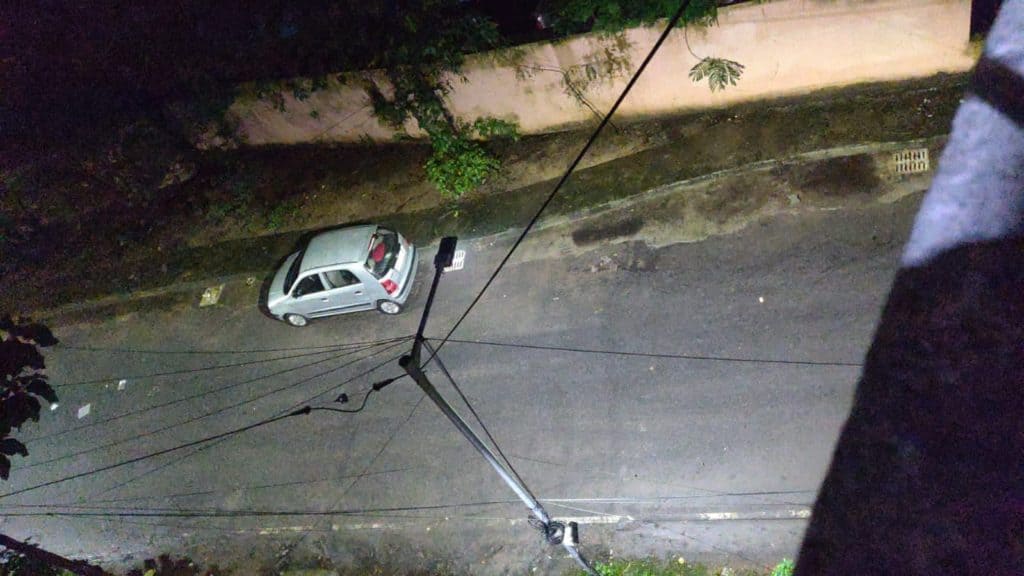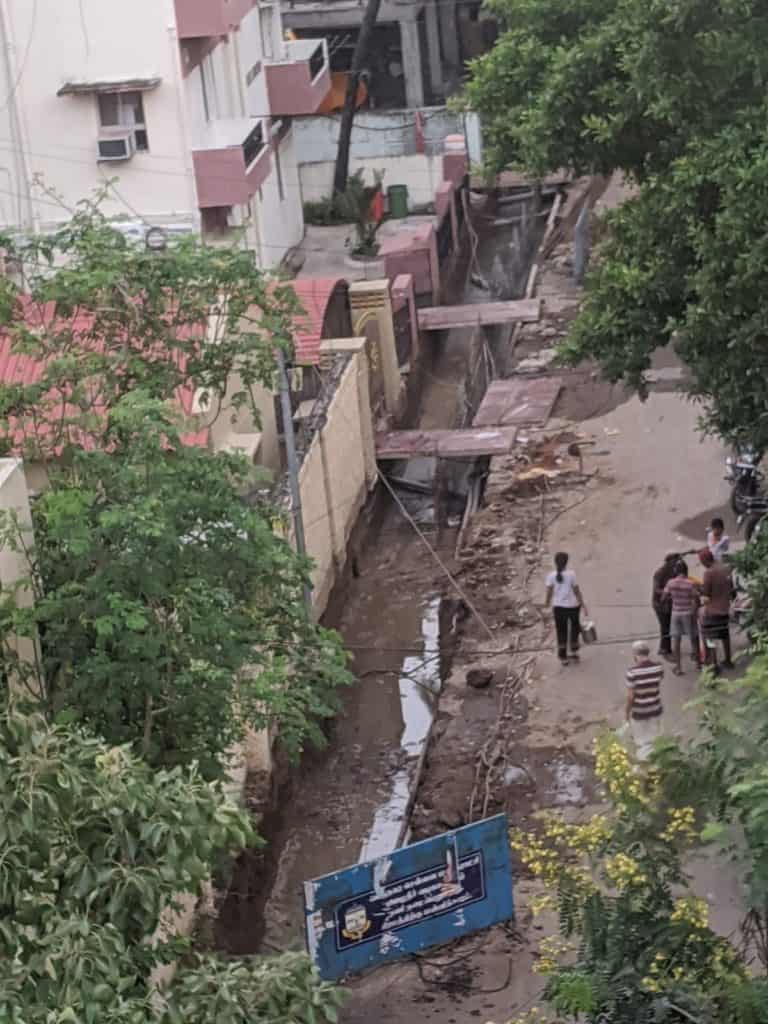The recent spate of rains in Chennai has seen the city flooded in large parts. The current Chennai floods are all over social media now, stark in the photos of inundated streets and water logging in many homes, especially those on the ground floor. The chaos has evoked angry and anguished responses from residents. There has been a chorus of demands, asking why the city’s stormwater drain network was unable to handle the rains and how the city would hold up in the event of further downpours that are predicted.
As part of a group of residents who suffered a similar fate during the Chennai floods of 2015, I would like to share my experience on how we managed to avert a similar situation this time. The years after the 2015 floods saw the residents of a few streets of Mandaveli come together to invest time and effort to ensure that the plight they suffered would not be repeated. That we succeeded to a large extent is evident from the fact that we have been able to avoid water-logging in the face of the rain fury a couple of days back.
Understanding flooding in our area
The TP Scheme Road where the Tamil Nadu Urban Development Project office is located now was totally submerged during the rains of 2015. Similarly the entrance of Velayutha Raja street and Kandaswamy Street which were the entrance roads to the inner streets of Raja street used to develop huge ponds after the mildest shower. Pedestrians and motorists used to find it very difficult to enter from these roads.
The RWAs of Mandaveli Raja Street and Poonga View had been formed at that point but we were not aware of the actual reason as to why the water logging occurred. During this time a group of good Samaritans in the area, including C R Balaji, a civic activist, helped educate the people about stormwater drains.
We attended an audit organised by Arappor Iyakkam which was very enlightening. We went in without knowing what kind of civic infrastructure is present in our streets but came out well-informed. This is when we realised why there was widespread flooding in our streets.

Read more: Madipakkam: Where roads disappear after a few spells of rain
SWD audits after Chennai floods
Once we got an idea about how the system works, we were more proactive in requesting the corporation officials for regular desilting, and audited the process whenever desilting of stormwater drains was undertaken. We built a rapport with the Assistant Engineer (AE) who oversees the works.
When the work was actually undertaken, a team of residents walked down with them and pointed out wherever they had spotted issues, such as mixing of sewage with stormwater or broken covers which let garbage enter the SWD. Many a time, the stormwater drains share chambers with sewage chambers, or cracked sewage pipelines cross over the SWD, so that sewage mixes with the stormwater flow; this is a critical issue that must be addressed if floods are to be avoided.
We also showed the officials the spots where there was excess silt and pushed for regular removal.
Process and results
Ensuring proper drainage requires sustained efforts and is a continuous process. We hit roadblocks such as when the Poonga shut off the drainage system from Raja Street and Poonga View Road, as mixed sewage was affecting marine life. With the help of the Corporation, this contamination was addressed. We have had many discussions on this subject with various officials over the years.
As a result of the regular audits that were conducted by us, we realised that parts of Poonga View Road, Raja Street and the entire TP Scheme Road, Velayutha Raja Street and Kandasamy Street did not have a complete, connected stormwater drain network. We petitioned GCC and also raised the issue in the media and whenever the AE visited, we pointed out the problems and submitted reports of the audits conducted by the community. It took two years to secure a go-ahead for the SWD completion project. The result of this work was put to test during the recent Chennai floods.

Read more: “Rethink urban development”: Author of new book on 2015 Chennai floods
Where once the roads were submerged and vehicles were a no go after the rains, we saw very little stagnation of water. What helped is also the construction of recharge wells at the sloping end point of Velayutha Raja Street, Raja Street, Kandaswamy Street and TP Scheme Road. We pooled funds and secured the permission to lay the recharge wells as we felt that only the excess water should go into the Stormwater Drains.
Also, when tar roads were relaid in Raja Street, the RWA followed up with the officials to make sure that the entire road was milled and laid. The exact location of the recharge wells and stormwater drains was conveyed to the officials in charge of the road work, so that they ensured the slope in such a way that water automatically flows into the drains.
Working with officials
The key learning for us from this experience has been the importance of continuous interaction and follow ups with officials. We have learnt that we must not shut our doors when civic works are carried out but instead try to understand the process.
If we wait for the work to be completed to spot the flaws, it is often too late and hence ineffectual; on the contrary, a proactive approach could prevent issues from the start and ensure an effective solution to the problem. We have found that working with officials and interacting with workers usually help nip issues at the bud and also solve additional problems that may be present in the area.

Hats off to the RWAs..people’s participation is quite essential in solving such civic issues.
A similar pro-activ3 stand from our KCWA, Kalakshetra colony paid off well post the disastrous 2015 floods .Yes we as EC members of the association and a few other hood Samaritans had to constantly escalate, follow up and work alongside the GCC officials to get the necessary road laying done and we saw to it that existing RWH wells were well audited periodically, se.were redone, more installed after identifying the slops and of course cleaning of the wells and desilting were done effectively. Hopefully this year we will tide over the impending heavy rains without much water logging.
No one reached out to Jethnagar residents association to find out how we managed.. sorry how we could get support from the top brass of the civic bodies.
Next time lets make it more inclusive
I am seetha kumar, resident of north usman road,t.nagar.as i read the above article,i understand the mention of sewage chambers shared the stormwater flow in mandaivelli, and was in due course brought to the attention of offi ials, hence the problem was addressed, (was it solved)no idea. Similar problem has resulted in “backwashing sewage into our house” for the past one month and despite complaining no action has been taken..T.Nagar Northusman road ,Parthasarathy road intersection is worst hit and 15 mins of rain will flood this area ..Nothing worst than inhaling the foul smell of sewage spreading across our backyard and seeping into the well as well.we worry for the 100yr old father and 92 yr old mother living in the same premises..
Congrats. I would like to add the following:
1. Depth of storm water drainage should not be more than
2 feet. If you increase the depth, sedimentation takes place
and clogging occurs.!
2. Interconnection slope and it’s direction is the need for proper
drainage
3. RWH out flow requires filtration and ican be taken into
Into a well or injected into bore well. 6 inches dia pipe can encase
filled with sand will facilitate percolation of water and the
table.
4. Advocation of open well will help in maintaining
water table and also rain water harvest
Thank you and I accept
People participation is so important and congrats to the RWAs for their good work. However the long pending action is wholesome integrated approach for watershed management, surface water management and waste management. First long lasting concrete roads casted in parts with joints like in Mumbai is so important after planning of all underground services. Remove encroachments, garbage, pollutants or any obstruction in all water bodies, lakes, ponds, tanks, rivers, streams, canals, parks, open spaces and allow water to percolate into aquifers or storage areas. Create new parks, water tanks (surface and underground) to atleast partially compensate encroachments. Plant trees along boundaries of all water bodies mentioned above including rivers.Enforce rain water harvesting in coordination with RWAs. After all water is soaked or stored, provide storm water drain network for excess water to drain. Use digital technolgies to centrally check the flow or obstruction and inspect wherever pumping is required. Never allow mixing waste and precious rain water. Invite best mind in industry to provide integrated plan and execute in time bound manner before next rain so that historic flood and historic drought do not repeat. Letd not be next Cape Town.